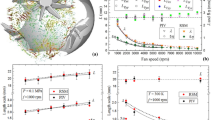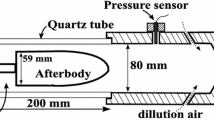Abstract
A fan-stirred combustion chamber is developed for spherically expanding flames, with P and T up to 10 bar and 473 K, respectively. Turbulence characteristics are estimated using particle image velocimetry (PIV) at different initial pressures (P = 0.5–5 bar), fan frequencies (ω = 0–2000 r/min), and impeller diameters (D = 100 and 114 mm). The flame propagation of methanol/air is investigated at different turbulence intensities (u′ =0–1.77 m/s) and equivalence ratios (ϕ = 0.7–1.5). The results show that u′ is independent of P and proportional to ω, which can be up to 3.5 m/s at 2000 r/min. LT is independent of P and performs a power regression with ω approximately. The turbulent field is homogeneous and isotropic in the central region of the chamber while the inertial subrange of spatial energy spectrum is more collapsed to −5/3 law at a high ReT. Compared to laminar expanding flames, the morphology of turbulent expanding flames is wrinkled and the wrinkles will be finer with the growth of turbulence intensity, consistent with the decline of the Taylor scale and the Kolmogorov scale. The determined SL in the present study is in good agreement with that of previous literature. The SL and ST of methanol/air have a non-monotonic trend with ϕ while peak ST is shifted to the richer side compared to SL. This indicates that the newly built turbulent combustion chamber is reliable for further experimental study.
Similar content being viewed by others
References
Kobayashi H, Kawabata Y, Maruta K. Experimental study on general correlation of turbulent burning velocity at high pressure. Symposium (International) on Combustion, 1998, 27: 941–948
Wang J, Matsuno F, Okuyama M, et al. Flame front characteristics of turbulent premixed flames diluted with CO2 and H2O at high pressure and high temperature. Proceedings of the Combustion Institute, 2013, 34(1): 1429–1436
Nie Y, Wang J, Zhang W, et al. Flame brush thickness of lean turbulent premixed Bunsen flame and the memory effect on its development. Fuel, 2019, 242: 607–616
Kejin M, Yue W, Yu L, et al. Observation of premixed flame fronts by laser tomography. Frontiers of Energy and Power Engineering in China, 2008 2: 427–432
Yan R, Chen Z, Guan S, et al. Influence of mass air flow ratio on gas-particle flow characteristics of a swirl burner in a 29 MW pulverized coal boiler. Frontiers in Energy, 2021, 15(1): 68–77
Sokolik A S, Karpov V P, Semenov E S. Turbulent combustion of gases. Combustion, Explosion, and Shock Waves, 1967, 3: 36–45
Karpov V P, Severin E S. Effects of molecular-transport coefficients on the rate of turbulent combustion. Combustion, Explosion, and Shock Waves, 1980, 16(1): 41–46
Bradley D, Haq M Z, Hicks R A, et al. Turbulent burning velocity, burned gas distribution, and associated flame surface definition. Combustion and Flame, 2003, 133(4): 415–430
Huang Z, Wang J, Hu E J, et al. Progress in hydrogen enriched hydrocarbons combustion and engine applications. Frontiers in Energy, 2014, 8(1): 73–80
Ge H, Norconk M, Lee S, et al. PIV measurement and numerical simulation of fan-driven flow in a constant volume combustion vessel. Applied Thermal Engineering, 2014, 64(1–2): 19–31
Mannaa O A, Mansour M S, Chung S H, et al. Characterization of turbulence in an optically accessible fan-stirred spherical combustion chamber. Combustion Science and Technology, 2021, 193(7): 1231–1257
Sick V, Hartman M R, Arpaci V S, et al. Turbulent scales in a fan-stirred combustion bomb. Combustion and Flame, 2001, 127(3): 2119–2123
Weiß M, Zarzalis N, Suntz R. Experimental study of Markstein number effects on laminar flamelet velocity in turbulent premixed flames. Combustion and Flame, 2008, 154(4): 671–691
Galmiche B, Mazellier N, Halter F, et al. Turbulence characterization of a high-pressure high-temperature fan-stirred combustion vessel using LDV, PIV and TR-PIV measurements. Experiments in Fluids, 2014, 55(1): 1636
Xu S, Huang S, Huang R, et al. Estimation of turbulence characteristics from PIV in a high-pressure fan-stirred constant volume combustion chamber. Applied Thermal Engineering, 2017, 110: 346–355
Ravi S, Peltier S J L, Petersen E. Analysis of the impact of impeller geometry on the turbulent statistics inside a fan-stirred, cylindrical flame speed vessel using PIV. Experiments in Fluids, 2013, 54(1): 1424
Chaudhuri S, Saha A, Law C K. On flame-turbulence interaction in constant-pressure expanding flames. Proceedings of the Combustion Institute, 2015, 35(2): 1331–1339
Abdel-Gayed R G, Alkhishali K J, Bradley D. Turbulent burning velocities and flame straining in explosions. Proceedings of the Royal Society of London, 1984, 391: 393–414
Fansler T D, Groff E G. Turbulence characteristics of a fan-stirred combustion vessel. Combustion and Flame, 1990, 80(3–4): 350–354
Shy S S, i W K, Lin M L. A new cruciform burner and its turbulence measurements for premixed turbulent combustion study. Experimental Thermal and Fluid Science, 2000, 20(3–4): 105–114
Kitagawa T, Nakahara T, Maruyama K, et al. Turbulent burning velocity of hydrogen-air premixed propagating flames at elevated pressures. International Journal of Hydrogen Energy, 2008, 33(20): 5842–5849
Goulier J, Chaumeix N, Halter F, et al. Experimental study of laminar and turbulent flame speed of a spherical flame in a fan-stirred closed vessel for hydrogen safety application. Nuclear Engineering and Design, 2017, 312: 214–227
Sun Z Y, Li G X. Turbulence influence on explosion characteristics of stoichiometric and rich hydrogen/air mixtures in a spherical closed vessel. Energy Conversion and Management, 2017, 149: 526–535
Kim W K, Mogi T, Dobashi R. Effect of propagation behaviour of expanding spherical flames on the blast wave generated during unconfined gas explosions. Fuel, 2014, 128: 396–403
Liu C C, Shy S S, Peng M W, et al. High-pressure burning velocities measurements for centrally-ignited premixed methane/air flames interacting with intense near-isotropic turbulence at constant Reynolds numbers. Combustion and Flame, 2012, 159(8): 2608–2619
Jiang L J, Shy S S, Li W Y, et al. High-temperature, high-pressure burning velocities of expanding turbulent premixed flames and their comparison with Bunsen-type flames. Combustion and Flame, 2016, 172: 173–182
Chiu C W, Dong Y C, Shy S S. High-pressure hydrogen/carbon monoxide syngas turbulent burning velocities measured at constant turbulent Reynolds numbers. International Journal of Hydrogen Energy, 2012, 37(14): 10935–10946
Sun Z Y. Explosion pressure measurement of 50%H2–50%CO synthesis gas-air mixtures in various turbulent ambience. Combustion Science and Technology, 2018, 190(6): 1007
Ichimura R, Hadi K, Hashimoto N, et al. Extinction limits of an ammonia/air flame propagating in a turbulent field. Fuel, 2019, 246: 178–186
Xia Y, Hashimoto G, Hadi K, et al. Turbulent burning velocity of ammonia/oxygen/nitrogen premixed flame in O2-enriched air condition. Fuel, 2020, 268: 117383
Vancoillie J, Sharpe G, Lawes M, et al. The turbulent burning velocity of methanol-air mixtures. Fuel, 2014, 130: 76–91
Lawes M, Ormsby M P, Sheppard C G W, et al. Variation of turbulent burning rate of methane, methanol, and iso-octane air mixtures with equivalence ratio at elevated pressure. Combustion Science and Technology, 2005, 177(7): 1273–1289
Bradley D, Lawes M, Mansour M S. Correlation of turbulent burning velocities of ethanol-air, measured in a fan-stirred bomb up to 1.2 MPa. Combustion and Flame, 2011, 158(1): 123–138
Mandilas C, Ormsby M P, Sheppard C G W, et al. Effects of hydrogen addition on laminar and turbulent premixed methane and iso-octane-air flames. Proceedings of the Combustion Institute, 2007, 31(1): 1443–1450
Lawes M, Ormsby M P, Sheppard C G W, et al. The turbulent burning velocity of iso-octane/air mixtures. Combustion and Flame, 2012, 159(5): 1949–1959
Brequigny P, Halter F, Mounaïm-Rousselle C. Lewis number and Markstein length effects on turbulent expanding flames in a spherical vessel. Experimental Thermal and Fluid Science, 2016, 73: 33–41
Liu F, Akram M Z, Wu H. Hydrogen effect on lean flammability limits and burning characteristics of an iso-octane-air mixture. Fuel, 2020, 266: 117144
Wu F, Saha A, Chaudhuri S, et al. Propagation speeds of expanding turbulent flames of C4 to C8n-alkanes at elevated pressures: experimental determination, fuel similarity, and stretch-affected local extinction. Proceedings of the Combustion Institute, 2015, 35(2): 1501–1508
Hwang W, Eaton J K. Creating homogeneous and isotropic turbulence without a mean flow. Experiments in Fluids, 2004, 36(3): 444–454
Yang T S, Shy S S. Two-way interaction between solid particles and homogeneous air turbulence: particle settling rate and turbulence modification measurements. Journal of Fluid Mechanics, 2005, 526: 171–216
Pope S B. Turbulent Flows. Cambridge: Cambridge University Press, 2000
Tennekes H, Lumley J L. A First Course in Turbulence. Cambridge: MIT Press, 1972
Doron P, Bertuccioli L, Katz J, et al. Turbulence characteristics and dissipation estimates in the coastal ocean bottom boundary layer from PIV data. Journal of Physical Oceanography, 2001, 31(8): 2108–2134
Kelley A P, Law C K. Nonlinear effects in the extraction of laminar flame speeds from expanding spherical flames. Combustion and Flame, 2009, 156(9): 1844–1851
Veloo P S, Wang Y L, Egolfopoulos F N, et al. A comparative experimental and computational study of methanol, ethanol, and n-butanol flames. Combustion and Flame, 2010, 157(10): 1989–2004
Acknowledgements
This work was supported by the National Natural Science Foundation of China (Grant No. 52076171).
Author information
Authors and Affiliations
Corresponding authors
Rights and permissions
About this article
Cite this article
Zhao, H., Wang, J., Cai, X. et al. Development of a fan-stirred constant volume combustion chamber and turbulence measurement with PIV. Front. Energy 16, 973–987 (2022). https://doi.org/10.1007/s11708-021-0762-z
Received:
Accepted:
Published:
Issue Date:
DOI: https://doi.org/10.1007/s11708-021-0762-z




